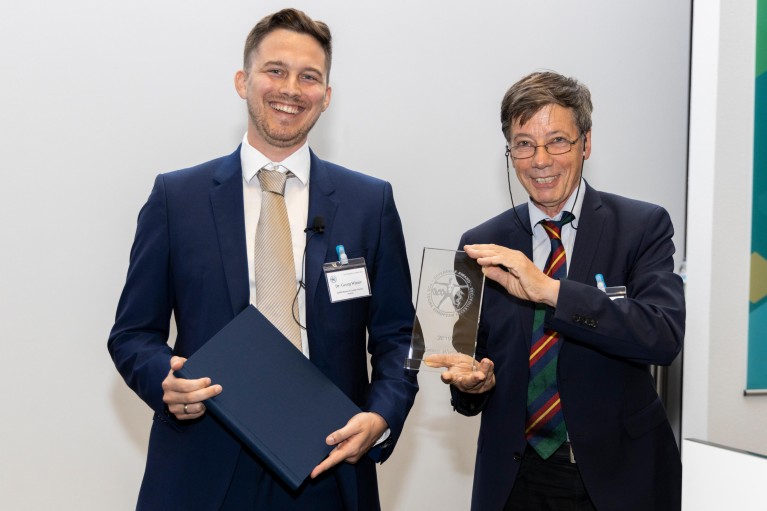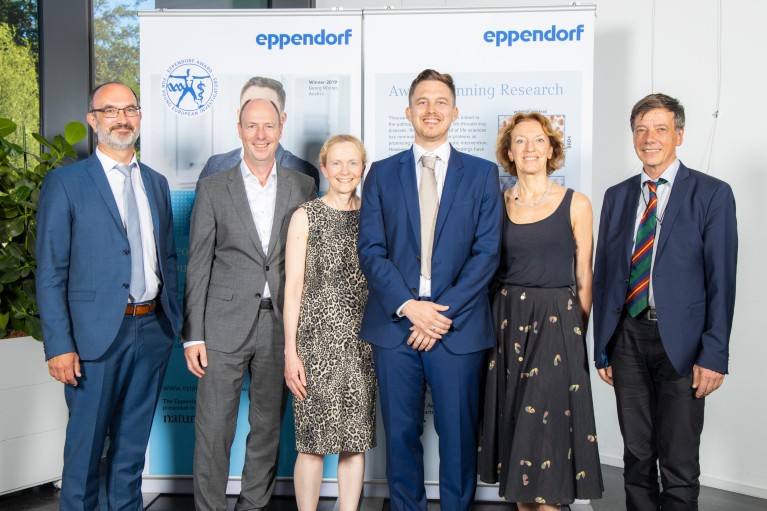
Georg Winter receives his Eppendorf Award from jury chair Reinhard Jahn.
Georg Winter, a chemical biologist at the CeMM Research Center for Molecular Medicine of the Austrian Academy of Sciences in Vienna, Austria, talks to science writer Geoff Marsh about his work on protein degradation. He describes his research on the notorious drug thalidomide, aiming to turn it into a ‘chemical knockout’ for cancer. This year’s ceremony took place at the EMBL Advanced Training Centre in Heidelberg, Germany, on 27 June, 2019.
Geoff Marsh: Congratulations for winning this year’s prize. You must be chuffed.
Georg Winter: It’s a huge honour, and a very humbling experience.
GM: The work you’re being celebrated for started with a key paper in 2015 in Science, detailing a new technique for targeting specific proteins for degradation. How does that work?
GW: It’s a relatively simple principle. We started out by making small molecules that have two ‘arms’, where one arm binds to a protein of interest, and the second binds to the protein degradation machinery, which is active in every cell. We call them ‘bifunctional molecules’, and we use them to reprogram the degradation machinery to eliminate a protein of interest.
GM: The drug you use to bind those two components is a phthalimide, which has a contentious history.
GW: Yes. The first phthalimide that you’ll have heard of is called thalidomide. It was marketed for morning sickness and as a sedative [in the 1950s], and it was taken by many pregnant women. Unfortunately, it turned out that if women took it in the first trimester of pregnancy, their babies were born with limb abnormalities. That particular molecule was withdrawn from the market, unfortunately only after around ten thousand babies were born with limb defects. For many decades, nobody wanted to touch thalidomide or its analogues. But it then became clear that they have very interesting anticancer activities.
GM: How does this phthalimide work?
GW: In 2010, a Japanese research group identified its cellular binding partner. This turned out to be a protein called cereblon which is a so-called E3 ligase. This is one of the proteins engaged in the cellular degradation machinery. Once we knew that thalidomide binds to this E3 ligase, the question was whether we could use this binding event to reprogram the machinery — by conjugating thalidomide to another small molecule that would bind to a protein of interest? Once that happens, we have these ‘heterobifunctional’ molecules that bind to both the degradation machinery and the protein of interest, bring the two together, and redirect the degradation activity to the target protein.

Left to right: Axel Jahns1, Wilhelm Plüster1, Laura Machesky2, Georg Winter, Maria Leptin2 and Reinhard Jahn2 Note:1Eppendorf AG, 2Eppendorf Award JuryCredit: EMBL Photolab, Heidelberg, Germany.
GM: In that 2015 paper, your target protein was one essential for the growth and survival of cancer, and you tested it in mice. How did that go?
GW: It was one of the key findings of the paper. We were already very excited to see that the molecule worked in a cancer-cell line in a dish. But the real test is in an animal model, to check whether it had some therapeutic potential. We were amazed by how well it worked. These mice already had a tumour growing. We took out the tumour and stained and quantified it for levels of a protein called BRD4. A couple of hours after a single treatment with this particular molecule, levels of the protein had decreased in the tumour; when we treated those tumour-bearing mice every day, the tumour growth was profoundly reduced. We slowed down the tumour growth by degrading a protein relevant to that cancer.
GM: Theoretically, could this phthalimide conjugation technique work for any protein target for which there is a ligand?
GW: That is a fair statement, and for some proteins we might even have ligands without knowing it. So far, we’ve only really cared about ligands that change protein function. But now, binding of the ligand can be entirely inconsequential — we just use it as an anchor to induce closeness to the protein degradation machinery. Often in cancer research we’re driven by genetic studies. For instance, we know that if we knock out a particular gene, we slow down cancer growth. But this particular gene might code for a protein with three different functionalities. Some of these functionalities might look like great targets for a small molecule ligand because they have been inhibited before. But it can be that inhibiting one functionality does not equate to knocking out or deleting the gene. We can now revisit all these cases because our chemical perturbation of degrading the protein is much closer to deleting it genetically than the conventional pharmacological way to just inhibit a protein’s function.
GM: So it’s kind of like a ‘chemical knockout’?
GW: Very much so.

Georg Winter discussing his research with Geoff Marsh, Nature Research.Credit: EMBL Photolab, Heidelberg, Germany.
GM: What do you think should be the next protein targets that would help the fight against cancer, using this technique?https://science.sciencemag.org/content/348/6241/1376.long
GW: We now have the tools to tackle some transcription co-activators and regulators of gene control. Ultimately, we should aim to target transcription factors for degradation. These will be the proteins with the highest bar, because for many of them we don’t have defined binding pockets to help us predict the ligand. But this will be the challenge and there are already strategies out there to tackle these limitations.
GM: How close is this technology to readiness for human trials?
GW: Not directly with the technology of phthalimide conjugation, but there have been some with other closely related heterobifunctional molecules that hijack another part of the protein degradation machinery and have similar functionality. There is one biotech company from Newhaven called Arvinas. They have started trials in humans to degrade a transcription factor, called the androgen receptor, in prostate cancer. This is, to the best of my knowledge, the first clinical trial. The entire field is eagerly waiting for the results.
GM: Finally, what’s next for you?
GW: We are very much interested in pushing this technology to the next limit and eventually being able to degrade proteins that we can’t bind. I’ll tell you how we plan to do this the next time we meet.


